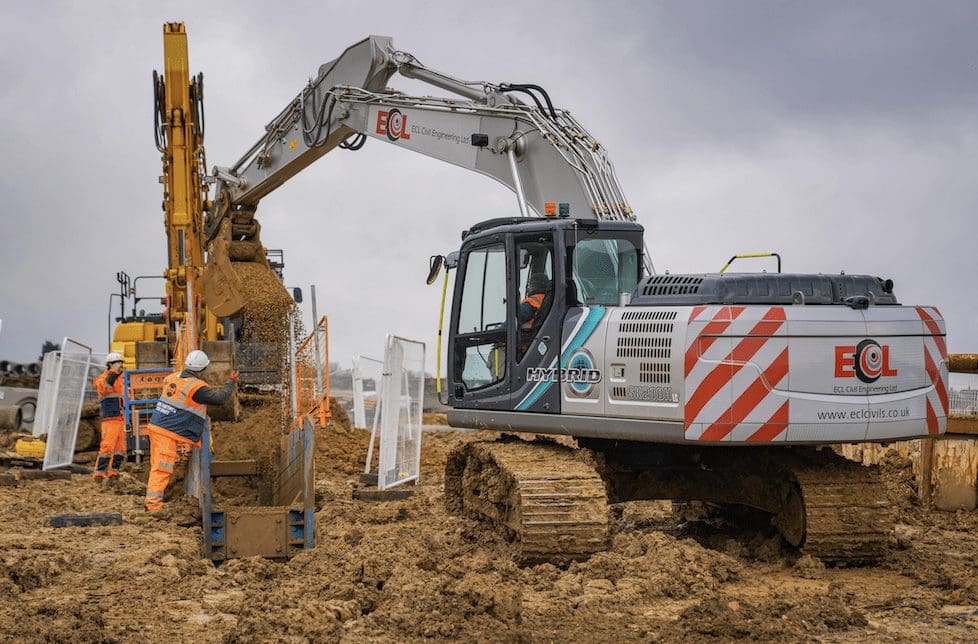This article explains the importance of groundworks in construction, emphasising their role as the essential initial phase of any building project. Credit: ECL Civil Engineering Groundworks encompass a series of preparatory construction activities conducted before actual building construction commences. These activities include excavating the land, laying foundations, installing drainage and sewer systems, and connecting utilities such as electricity, gas, and water. The primary objective of groundworks is to establish the foundational sub-structure necessary to support the entire building. – Groundworks involve below-ground construction work to prepare a site. – Main activities include excavation, foundations, drainage and service connections. – Creates the sub-structure required to support the building. – Carried out before above-ground building work can begin. Groundworks are a crucial first phase in any construction project. They don’t provide any aesthetic value, but create the necessary foundations and infrastructure to support the rest of the build. Excavating, laying foundations and installing services to the right depths and specifications is very skilled work. High-quality groundworks will ensure the structural integrity and stability of the property for years to come. Groundworks refer to the preparation and foundation work done before actual building construction can begin. It’s the first phase of any building project and involves breaking ground on a site to prepare it for the structural work ahead. Groundworks involve a variety of activities such as: In layman’s terms, groundworks get a site ready for building work to start. It’s the vital preparation needed before the visible construction of a project can begin. Once groundworks are completed, the surface is prepared for the next phase of construction to start. This typically involves laying foundations like concrete footings to support the building frame and structure. Groundworks are sometimes referred to as the ‘hidden’ phase of construction as much of the work is underground. But it’s an essential start for any building project. Before construction can begin, the ground must be prepared properly. This involves several key steps: A well-prepared site with proper groundworks ensures the ground can support the weight of the planned structure. It also provides a stable, level surface on which to construct foundations and build upwards. Drainage and underground utilities may also be installed at this stage so that the ground is fully ready for the real construction work to begin. While not as visible as the structure itself, groundworks are the crucial starting point on which the rest of the project depends. Credit: T&P Regeneration Once the initial groundworks are complete, more extensive excavation may be required depending on the project. Digging down further allows for: If toxic or hazardous materials are found, contractors must remediate the site to ensure its safety once more. This may involve removing and disposing of the contaminated soil correctly. Underpinning strengthens the foundations of any adjacent existing structures to prevent damage from the new construction works. Techniques like piling, grouting or shoring transfer the load away from the old foundations. These processes require careful planning and execution by experienced groundworks contractors. Following best practices prevents delays, and accidents and ensures the ground is ready for building. Commercial projects often require extensive groundworks before construction can begin. As well as excavating and laying foundations, it may involve: The scale of commercial groundworks demands meticulous planning and coordination. Detailed method statements and risk assessments are vital. A temporary works engineer oversees the temporary structures. And health and safety are paramount with multiple contractors on site. With care taken at the groundworks stage, commercial projects can proceed on time and on budget, delivering the robust foundations needed for buildings that serve their communities. Concrete is highly versatile and durable, ideal for commercial substructures. Contractors can pour it on-site or use cranes to place precast concrete sections. Factors like load-bearing requirements, ground conditions and building layout determine the concrete foundation design. Common types are: Reinforcing steel bars strengthens the concrete to handle loads. Also, waterproofing protects basements from damp and groundwater ingress. With care taken at the substructure stage, buildings stand on firm and stable foundations. Groundworks refer to the initial preparatory work done on a construction site before actual building work can begin. This includes excavation, laying foundations, installing drainage and sewer systems, and bringing in electricity, gas, water and other services. Groundworks create the necessary sub-structure to support the rest of the build. Groundworks refers to the initial below-ground construction activities that prepare and level a site for building work. It involves excavating the land, laying foundations, installing drainage and sewer systems, and bringing in main services like electricity and water. Groundworks create the necessary sub-structure to support the rest of the property build. Key activities include digging trenches, laying concrete foundations, installing drainage pipes, and backfilling.
What Is Groundworks in Construction?

Key Points
Our Opinion
What Are Groundworks in Construction?
Preparing the Ground
Excavation, Remediation and Underpinning

Commercial Groundworks
Concrete Substructures and Basements
FAQ
What is the meaning of groundworks in construction?
What are the examples of groundworks?
What is the process of groundworks?
What does a groundworks Labourer do?
Conclusion
